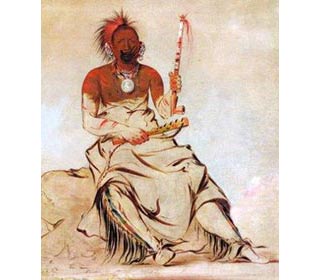Native American Whips - the Uses
Native American whips had various uses within the tribes: - Horse Whips: Horse whips were commonly used by the Great Plains tribes of Native Americans to goad their horses on during battles or during the chase for buffalo.
- Punishment Whips: Whips were used as a weapon of punishment within tribal societies by the Whip Man or by the Native Indians whose task was to 'police' the tribes, who were called the "akicita"
- Ceremonial Whips: Ceremonial Whips were also included as part of the regalia of Native Americans, as can be seen in the above picture by George Catlin. These ceremonial whips were seen as its symbols of power and status
Whips
Whips required minimal natural resources or technology to construct. The three types of whips used by the Native Americans, the horse whips, punishment whips and ceremonial whips were constructed using similar designs but the ceremonial whips were decorated with much greater care using carvings or paints to depict special symbols and occasionally embellished with feathers. Making Whips - The Handles and Lashes
Making Whips was not a difficult task and required just two major elements - the handle and the lash: - Making a handle for Whips: The handle was made using a hard wood or different types of bone or horn including the elk horn. The hardened woods used to make the handle included hickory, juniper, oak, cedar, maple, ash, walnut and birch.
- The size of the handles varied according to their purpose but generally measured between15-20 inches long
- The handles of the ceremonial whips were decorated with colored paints and carvings and occasionally embellished with feathers and beads
- Making lashes for whips: The materials used to make the lashes also varied according to their purpose but the horse whips were made of rawhide which was braided or twisted, or cut into wide straps. The horse whips were attached to the rider's wrist by a tough thong. Rawhide is a tough, heavy and durable material, it is not leather, but a de-haired hide from cattle, elk or deer, that is not tanned. Pieces of tanned hides or buckskin was also used to make the lash of the whips. These were made from left over pieces of leather and materials that had been used to make other weapons or items of clothing and equipment
Ceremonial Whips
Ceremonial whips were made as part of the regalia of a warrior. These whips were decorated with symbolic colorings and markings which were significant to the owner. These ceremonial whips were symbols of power and carried into battle for their protective power. Ceremonial Whips used at Pow-Wows - The Whip Man
A Ceremonial whip is used by the head organiser of a Pow-Wow who is referred to as the Whip Man. The Whip Man is responsible for making sure dancers are dancing during the Pow-Wow. The Whip Man carries a small braided whip he uses to point at flagging dancers. The role of the Whip Man holds considerable responsibility and this ominous title probably dates back to the first roles of the Whip Man - that of the punisher. The Whip Man and Children
The Whip Man was an official and respected position in many Native American tribes. His status was similar to that of a Medicine Man but his role was to impose punishments where this was necessary. Native Americans were very lenient to their children but should their behaviour warrant it the Whip Man was called who might use a willow switch to punish children. In this role he was also respected for his skills as a teacher who would teach children right from wrong. The Whip Man and the Akicita - the Punishers
Whip Man were also appointed to undertake the task of punishing adult offenders within a tribe. The instrument of punishment for theft were whips. The number of lashes administered by the Whip Man ranged from fifty lashes for the first offence, one hundred lashes for the second and death by the rifle for the third offence. The American Indian Akicita were the Warriors and Elders who had considerable powers in policing and organizing the tribes. The Akicita had the authority to impose punishment. The punishments included the destruction of the culprit's personal property and corporal punishment administered by use of the whip. |
